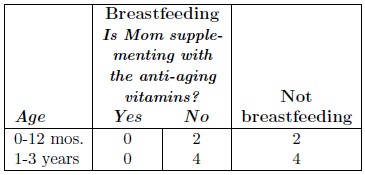
 | |
| Volume 10, Number 14 | July 24, 2020 |
Previous intake estimates for Dr. Aardsma's Anti-Aging Vitamins dietary supplement recommended 0 intake for children under the age of 4.[1] This recommendation assumed that the physiological need for the anti-aging vitamins in infants and toddlers would be met through maternal transfer of the anti-aging vitamins via breast milk. It was also assumed that any infant or toddler who didn't get quite enough of the anti-aging vitamins (e.g., weaning before age 4) had plenty of time to recover via later supplementation without undue risk of negative effects. Our current understanding of human aging[2] overthrows the latter assumption. We now believe that an adequate intake of the anti-aging vitamins in the early years of childhood is absolutely essential to prevent the onset of the potentially incurable Aging 2 disease. Therefore, a more detailed look at intake recommendations for infants and toddlers is provided in this update.
 |
For infants and toddlers who are exclusively breastfed and who's mother is supplementing her diet with the anti-aging vitamins, the recommended intake of the anti-aging vitamins for the child is 0 drops. Both MePA and MePiA are water soluble and can be assumed to be present in breast milk. With nearly all nutrients, the supply in the mother's milk is matched to the needs of the infant. Therefore, it is a reasonable assumption that any physiological need that the exclusively breastfed infant or toddler has for the anti-aging vitamins will be satisfied simply by nursing, as long as the mother is consuming the anti-aging vitamins. This conclusion is supported by the long lifespans of pre-Flood people[3] who, long before the invention of infant formula or baby food, would have relied on breast milk as the primary source of nutrition (including the anti-aging vitamins) for infants and toddlers.
For babies who are not able to be breastfed, or who's mother is not consuming the anti-aging vitamins, the situation is more complicated. The recommended daily intake of most nutrients for babies is determined by measuring the concentration of the nutrient in breast milk and multiplying that concentration by the average daily intake of breast milk. This is a measurement we hope to make in the not too distant future. Until this measurement has been made, the values presented in Table 1 may be used as ballpark estimates.
The values in Table 1 were calculated by assuming that the concentration of the anti-aging vitamins in breast milk was equal to the level of the anti-aging vitamins in drinking water pre-Flood. This assumption likely overestimates the levels of the anti-aging vitamins in breast milk, but, as has been discussed previously,[4] there is considerably more risk due to inadequate consumption of the anti-aging vitamins than there is due to excessive consumption of the anti-aging vitamins. Next, breast milk intakes were assumed to be equivalent to total water intakes (food derived plus liquid water consumption). These intake values[5] were then multiplied by the estimated pre-Flood concentration of the anti-aging vitamins (6.76 μg/L), which is the basis of the current recommended daily intakes for the anti-aging vitamins.[6]
Since the human body does a remarkably good job of matching the composition of breast milk to the needs of the baby, the best way to ensure that infants and young toddlers are getting the right amount of the anti-aging vitamins is for the mother to supplement her diet with the anti-aging vitamins and for breast milk to be the primary source of nutrition for the child. However, in cases where that is not possible, supplementation of the child's diet with the anti-aging vitamins at the levels given in Table 1 can reasonably be expected to meet the physiological need of the child for the anti-aging vitamins. ◇
The Biblical Chronologist is written and edited by Gerald E. Aardsma, a Ph.D. scientist (nuclear physics) with special background in radioisotopic dating methods such as radiocarbon. The Biblical Chronologist has a fourfold purpose: to encourage, enrich, and strengthen the faith of conservative Christians through instruction in biblical chronology and its many implications, to foster informed, up-to-date, scholarly research in this vital field, to communicate current developments and discoveries stemming from biblical chronology in an easily understood manner, and to advance the growth of knowledge via a proper integration of ancient biblical and modern scientific data and ideas. The Biblical Chronologist (ISSN 1081-762X) is published by: Aardsma Research & Publishing Copyright © 2020 by Aardsma Research & Publishing.
|
^ Gerald E. Aardsma, "Intake Recommendations for Dr. Aardsma's Anti-Aging Vitamins," The Biblical Chronologist 10.10 (June 10, 2020): 1–8. www.BiblicalChronologist.org.
^ Gerald E. Aardsma, "Human Aging is a Two-Phase Disease", The Biblical Chronologist 10.8 (May 13, 2020). www.BiblicalChronologist.org.
^ Gerald E. Aardsma, Aging: Cause and Cure (Loda, IL: Aardsma Research and Publishing, 2017), pages 27-34. www.BiblicalChronologist.org.
^ Matthew P. Aardsma, "Intake Recommendations for Dr. Aardsma's Anti-Aging Vitamins", The Biblical Chronologist 10.10 (June 10, 2020). www.BiblicalChronologist.org.
^ The National Academy of Sciences. Dietary Reference Intakes for Water, Potassium, Sodium, Chloride, and Sulfate. Pages 140-143, 2005.
^ Matthew P. Aardsma, "Intake Recommendations for Dr. Aardsma's Anti-Aging Vitamins", The Biblical Chronologist 10.10 (June 10, 2020). www.BiblicalChronologist.org.